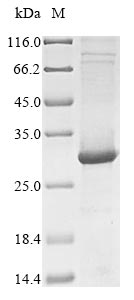Amino acids 861-1049 form the expressed segment for recombinant Human TLR7. The expected molecular weight for the TLR7 protein is calculated to be 29.5 kDa. This TLR7 recombinant protein is manufactured in e.coli. The TLR7 coding gene included the N-terminal 10xHis tag and C-terminal Myc tag, which simplifies the detection and purification processes of the recombinant TLR7 protein in following stages of expression and purification.
Toll-like receptor 7 (TLR7) is a critical component of the innate immune system, belonging to the Toll-like receptor (TLR) family. TLR7 is predominantly expressed in immune cells, such as dendritic cells and macrophages, and is located within endosomal compartments. It plays a key role in recognizing single-stranded RNA from viruses. Upon binding to its ligands, TLR7 activates signaling pathways that involve the adaptor protein MyD88, leading to the activation of transcription factors like NF-κB and the production of pro-inflammatory cytokines, interferons, and other immune mediators. TLR7 is especially important in antiviral responses, contributing to the host defense against viral infections. Research on TLR7 aims to elucidate its signaling cascades, identify specific ligands, and understand its role in various diseases. Additionally, TLR7 agonists are explored for their potential in vaccine development and immunotherapy against viral infections and certain cancers.






